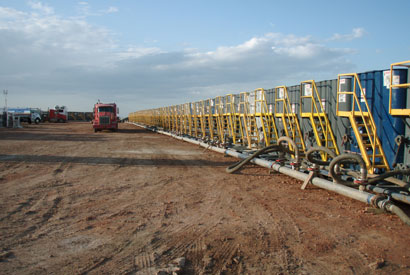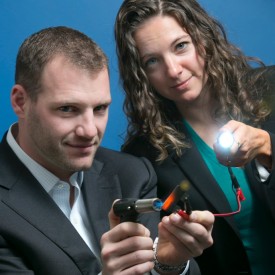Symposium spotlights clean-technology solutions
Through the Cleantech to Market program, scientists and students are working together to bring new, environmentally friendly innovations to the world.

January 10, 2014
In the atrium of Sutardja Dai Hall, a screen displayed real-time results as audience members texted votes they based on what they’d just seen on stage.
It wasn’t a campus version of American Idol. The audience was voting on favorites from a spate of innovative, environmentally friendly energy technologies being developed and refined through Cleantech to Market (C2M), a unique collaboration of UC Berkeley and the Lawrence Berkeley National Laboratory.
The technologies – eight in all – were presented to approximately 150 faculty and staff members, students, scientists and energy-industry professionals at the Cleantech to Market program’s fourth annual symposium. Making the presentations were teams of graduate students who’d been working closely with UC Berkeley and Berkeley Laboratory scientists through the program. The students’ goal: figure out how to take the scientists’ work out of the lab and into the world via commercialization.

Cleantech to Market team lead Michael Lebow and College of Engineering Ph.D. candidate Sibel Leblebici demonstrate an innovative new fuel cell that’s part of a plan for reducing the environmental impact of fracking. (Jim Block photo)
“The problem we’re solving for the scientists is that they’ve been achieving technical scientific breakthroughs but not market breakthroughs,” explains Brian Steel, co-director of the Cleantech to Market program. “Unless you can translate those breakthroughs into terms the market is willing to value, it becomes increasingly difficult to get the next research grant or keep your best scientists working on something.”
C2M was launched in 2008 as a pilot program by the Berkeley Lab and the Berkeley Energy and Resources Collaborative. It later expanded via a partnership with Berkeley’s Haas School of Business, which created a Cleantech to Market course as part of its Berkeley Innovative Leader Development program.
Berkeley Lab and UC Berkeley scientists submit low-carbon energy projects they’ve been working on, and those that are picked for the program are assigned to teams of Haas students working with graduate students from a variety of other campus schools. Each team then does exhaustive market research, identifying potential customers, investors and industry partners and addressing roadblocks to commercial development.
“UC Berkeley is perfectly positioned to do something like this,” says Steel. “It’s one of the preeminent research universities in the world. There’s an amazing array of fundamental research going on, particularly in the clean-tech area. And the caliber of students here across a wide variety of programs is top notch. We draw from 20 programs, and this wouldn’t work if half of them were substandard. But we can get world-class students in all these different disciplines.”
Haas MBA candidates and Cleantech to Market participants Michael Lebow and Jonathan Lim say it was the chance to dip into that deep pool of talent that drew them to Berkeley in the first place.
“C2M was one of the key reasons I came to Haas,” Lebow says. “The Bay Area has an incredibly strong cleantech scene, and Cleantech to Market offers a hands-on opportunity to get involved.”
“The technology we were able to work with was fascinating, and the mentorship of [C2M program co-director] Beverly Alexander and Brian Steel was top-notch. However, the best part of the course was the team itself,” says Lim.
This year’s teams focused on such cutting-edge ideas as using tobacco as a biofuel and developing a “smart” window that adjusts itself depending on the weather. The audience voted on its favorites in three categories. The “People’s Choice” award went to a team presenting a method for reducing the amount of gas vented into the atmosphere during “fracking” operations in remote locations. The “Rocked It!” award went to a presentation on a more efficient way of measuring power distribution, while “Game Changer” went to Lim’s team, which had done a market-feasibility study for a solar-powered pump that could provide clean, low-cost drinking water in the developing world.
“The symposium was an incredibly valuable component of the C2M class,” says Lebow, who served as team lead on the venting-reduction project. “The format of the class forced us to develop a pitch early in the process, while we were still in the research stage. This felt a little backward at the time, but proved to be crucial to our success. It taught us how important it is to start thinking about your message early on and how you must craft your story to deliver a clear message to your audience.”
Haas MBA candidate Brett Foreman, team lead for the power-distribution system project, also cites the emphasis on clear, concise messaging as one of the most important takeaways from his symposium experience.
“The presentation allowed the team to practice developing a simple story about a complex technology and industry – a task not to be underestimated,” he says.
According to Steel, the awards were a way to add some fun to the proceedings, but they can also portend future success. For instance, last year’s “People’s Choice” winner, a system for saving energy by optimizing the pressure in buildings’ air ducts, incorporated under the name Slice Energy and went on to secure a $95,000 grant from the California Energy Commission. In fact, since UC Berkeley got involved with the Cleantech to Market program four years ago, 20 percent of the projects have gone on to be incorporated, raising $15 million in investments, grants, awards and revenue. And research and development continues on several other past projects thanks to millions more in grants.
Steel thinks the public presentations at the symposium have something to do with that post-Cleantech to Market success. The teams are coached extensively beforehand, with outside mentors from venture-capital firms and clean-tech companies coming in for critiques Steel calls “tough-love dry runs” that force the students to take a hard look at their presentation skills.
“Hopefully those are life lessons that they will carry with them whatever they do,” Steel says. “Whether they’re presenting a grant proposal to a committee or presenting to a board of directors, they’ll remember what they learned here.”